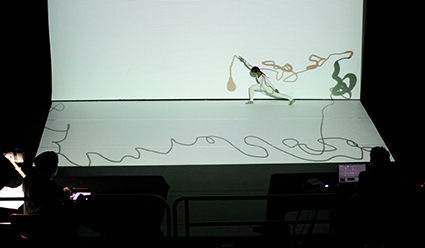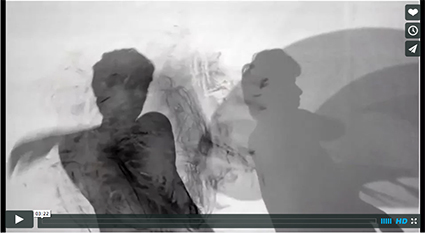Dance & drawing: ways of seeing trace
Megan Fizell: interview with Todd Fuller
Flatline Showing SKETCH (Carriageworks, 2013)
Anya Mckee
Flatline Showing SKETCH (Carriageworks, 2013)
Flatline is a Sydney-based interdisciplinary performative collaboration between Australian visual artist Todd Fuller and dancer-choreographer Carl Sciberras. Their work melds drawing and mark making with the choreographed movements and gestures of professional dancers. Fuller discussed with me the idea of ‘trace’ and its application to the hybrid dance/art performances of Flatline.
In the performances, you engage physical objects and digital technologies for your mark making. Do you prefer one to the other or are both essential in the development of Flatline?
They are two different technologies that essentially enable us to explore the same thing, ‘trace.’ “Trace” is a term coined by the South African artist William Kentridge; it is the remnant or the history of a mark or action. Kentridge talks about trace regularly across his writing and interviews, and in the book William Kentridge: five themes, he writes about erasure and the traces it leaves as being about the passage of time and hence memory. In Flatline’s case, ‘trace’ is applied to a dancer in motion to make a permanent reference to an ephemeral act.
One of the interesting things about this intersection of art and dance is the displacement of an object, which occurs in dance. A choreographer will spend years composing a work that lives in the audience’s collective memory, which is an un-trustable and unstable record. Dance is by nature a temporal action; it leaves nothing in its aftermath other than an experience. This contrasts with visual arts practices, which are typically engaged in the act of making a tangible thing that often entails a definitive volume, space, and material.
Flatline attempts to shift this dynamic. Through drawing, the memory of a movement is mapped; it is drawn on paper in a way that can be made permanent in a space. Therefore the ‘trace’ becomes a physical signifier of an act, the memory is materialised, which enables dance to create something permanent. Both the digital and the physical will continue to be important to Flatline, but our focus is on their combination.
,_2014.jpg)
Flatline, Sketch
2014, photo Anya McKee
Flatline, Sketch
The first Flatline performance, The Launch of Flatline (2011), saw the dancers responding to a projection of your hand-drawn animations while Sketch (2014) saw an active engagement between yourself and the dancers with live sketches projected on both the walls and their bodies. Tell me about the technologies you use and how they have evolved.
Early on we recognised the immense potential for drawing and dance to partner one another, but we didn’t have the skills or technologies to make it happen in a meaningful way. Stumbling across an epidiascope (a live feed device or ELMO Projector) was an early first key to the puzzle.
The ELMO is a unique device with a powerful almost microscopic lens and multiple lighting options allowing for a range of effects. It offers many challenges, including a shift in scale, which takes a lot of control to manage. A centimetre line on my page may span the length of a dancer’s arm on the stage and a great deal of training was necessary to handle this tool.
I was introduced to Tagtool by the artist Kellie O’Dempsey and began using the program once it was translated into an iPad application. It’s an ambidextrous device where one hand generates the drawing and the other manipulates the quality, colour, depth and density of the line. Algorithms controlling the movement, speed and direction of the drawings are triggered through slight gestures. The resulting marks are digital; the colours can be quite extreme and are the antithesis of my solo animation and drawing practice. I spent time learning to manipulate Tagtool with only my hands in order to free my eyes to track and react to the movements of the dancers.
.jpg)
Flatline, Imprint 2014, Brenda May Gallery, Sydney
photo courtesy the artists
Flatline, Imprint 2014, Brenda May Gallery, Sydney
Crayon shoes are another tool we utilise in our exploration of the “dance trace.” These performances, the most recent being Imprint (2014) at Brenda May Gallery in Sydney, turn the dancer into an incidental drawer and remove my hand and drawing ‘choices’ from the process. What I find particularly exciting about these performances is that they force a dancer to make decisions about mark making while still operating from a dance perspective. On a recent residency the dancers completed drawing lessons in order to understand the elements and principals. It is fascinating to watch these skills now inform their choices as dancers.
The shoes came about in collaboration with a wonderful mould expert, Claire Tennant. We spent hours figuring out how to create them so that they would be functional. Some shoes are dipped in wax but others are cast from moulds. They malfunction and their degradation is important, but it must be timely, so we had to create a structure to enable a dense crayon sole that would not break down too quickly.
Where do you look for inspiration in the development of your performances?
To be honest it changes every time, some pieces simply come back to basic elements. For example, in 2014 at Parramatta Lanes we presented a series titled lines of contact. These are pure unadulterated call and response actions between artist and dancer. The piece is performed in a spatially dynamic site, which enhances the exchange, but it’s essentially an interaction between choreography and drawing.
Some pieces are about playing with an idea. The performance drawn duet III (2014) at Queensland University of Technology was a power struggle between visual art and dance, which in turn, became a metaphor for the greater struggle—or dialogue—between an artist and their idea. The dynamics between the maker, the muse, the subject, the collaborator and the work all become key subjects within the performances.
A Dance for Paul Klee (2014) marks Flatline’s first foray into film. Tell me about the developmental process?
This isn’t our first film but it is the first we exhibited. We have been making films for a few years using simple methods and motifs. A dance for Paul Klee is an intersection of ideas and processes beginning with choreography, which was developed from a mark making perspective. Our dancers and choreographer took drawing lessons during a residency at Bundanon Trust and generated dance material in response to the marks they made. These movements were developed into a sequence that was practiced and perfected on the banks of the Shoalhaven River, the same location made famous by the Australian painter Arthur Boyd. We filmed it from above before transcribing it into a hand-drawn animation in which the ‘trace’ marks are accentuated by red chalk. The animation and original footage were then overlaid and the timing was tweaked, in order to allow the pair to oscillate in and out of sync. We have an ongoing interest in how animation has the capacity to augment a body in motion. A dance for Paul Klee exemplifies this interest, while referencing the drawing theories that form a cornerstone of our line of interrogation.

Flatline
photo courtesy the artists
Flatline
Although Carl is credited as the dancer-choreographer of Flatline, you are also a dancer. Has this shared background enabled you to come together to create Flatline and how do you draw on your dance experience?
Our dancers and Carl would laugh at that question; my dance training is quite limited! When I am making decisions about a drawing, I am often tapping or pacing. Moving is an important part of my process. While Flatline is developing a new piece, I will often sneak a dance in the corner, but to call myself a dancer next to the trained professionals would be a bit of a farce. That said, my teenage years in the dance studio definitely helped form a strong foundation for Carl and I to communicate across genres–as does Carl’s knowledge of the visual arts.
How does your collaborative work with Flatline inform your solo practice as an artist? Are you finding that the two are becoming more entwined?
It really is a blurred area and one that is increasingly hard to negotiate—where does Flatline stop and Todd Fuller start? Does there need to even be a differentiation? I was interested in dance themes before Flatline; my earliest sculpted character was a fat man in a tutu. I would like to think that through working with Carl and developing Flatline, my understanding of dance is a bit more informed and that I can now successfully articulate these ideas through drawing and animation.
Flatline www.flatline.net.au
Todd Fuller is represented by Brenda May Gallery and Carl Sciberras is associated with FORM Dance Projects.
Megan Fizell is a Sydney-based writer and curator.
RealTime issue #127 June-July 2015 pg. 21







